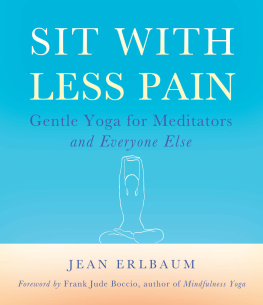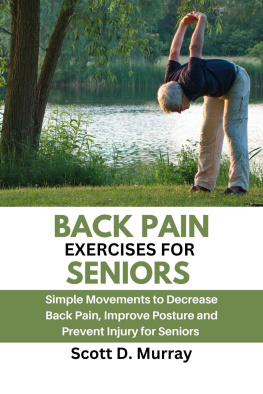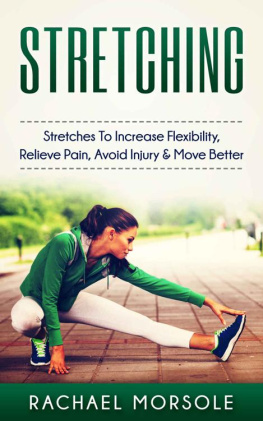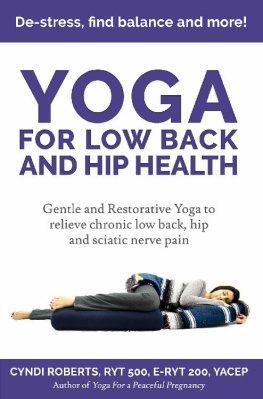SIT WITH LESS PAIN

Jean Erlbaums book is a true blessing for everyone who has a body. Everyone should own this amazing book.
Melissa Myozen Blacker, coeditor of The Book of Mu
Whether you spend your days in the temple or in the boardroom, Sit with Less Pain is the perfect companion guide to remaining comfortable and pain-free. A must-have for everybody who sits!
Willa Miller, coauthor of The Arts of Contemplative Care
RELIEVE AND RELEASE THE STIFFNESS THAT COMES FROM PROLONGED SITTINGAT A DESK, BEHIND THE WHEEL, OR ON A MEDITATION CUSHIONWITH THESE EASY-TO-FOLLOW EXERCISES.
A nyone who sits for long periods knows the discomfort of cramping joints and aching backs; free yourself from pain with this beautifully illustrated guide. The book is organized anatomically, helping you to immediately focus on the part of the body that causes you pain: tense shoulders, stiff knees, sore hips, etc. For readers who have mastered the individual stretches and want a more intensive experience, Sit with Less Pain also includes instructions for sequences that combine several exercises into a flowing series of movements.
Gorgeous, clear illustrations and lay-flat bindingwhich lets the book stay open at the proper pagewill help you perfect the poses. Also included are variations on stretches that can be done seated in a chair, for those who are wheelchair-bound or just feel more comfortable sitting.
Not only do my eyes see the beauty in this much-needed book for meditators and anyone who sits on any chair, my heart is happy that we finally have this well-mapped-out guide. Thank you, Jean!
Lakshmi Voelker, founder of Lakshmi Voelker Chair Yoga

Jean Erlbaum, MS, ERYT, LVCYT, has been studying yoga and meditation since 1965 and has been teaching since 1972. She is certified as a teacher of several styles of yoga, meditation, and stress reduction. She has studied Zen for over thirty years and in 2012 was designated as a senior Dharma teacher by Boundless Way Zen.
Wisdom Publications
199 Elm Street
Somerville, MA 02144 USA
www.wisdompubs.org
2014 Jean Erlbaum
All rights reserved.
No part of this book may be reproduced in any form or by any means, electronic or mechanical, including photography, recording, or by any information storage and retrieval system or technologies now known or later developed, without permission in writing from the publisher.
The practices in this book are not suggested as a substitute for medical care or advice. As with any new exercise program, it is best to consult with your doctor if you have any questions or concerns about doing any of the stretches in this book. Neither the publisher nor the author shall have responsibility or liability for any loss or damage caused directly or indirectly from the information contained in this book.
Library of Congress Cataloging-in-Publication Data
Erlbaum, Jean, author.
Sit with less pain : gentle yoga for meditators and everyone else / Jean Erlbaum ; illustrated by Michelle Antonisse.
pages cm
Includes bibliographical references.
ISBN 0-86171-679-5 (pbk. : alk. paper)
1. PainAlternative treatment. 2. Hatha yogaTherapeutic use. 3. Mind and body. I. Antonisse, Michelle, illustrator. II. Title.
RB127.E75 2014
613.7046dc23
2013050118
ISBN 9780861716791 Ebook ISBN 9780861716845
18 17 16 15 14 5 4 3 2 1
Cover design by Phil Pascuzzo.
Interior illustrations by Michelle Antonisse.
Interior design by Gopa&Ted2, Inc..
To my dear friend, writing mentor, and Dharma sister Genie Zeiger (19432009):
Thank you for your ideas for this book, which you generously gave to me over your last few months, and for coming back to sit on my left shoulder and whispering suggestions in my ear until it was done.
The mind is like the wind and the body like the sand: if you want to know how the wind is blowing, you can look at the sand.
BONNIE BAINBRIDGE COHEN,
Sensing, Feeling, and Action: The Experiential Anatomy of Body-Mind Centering
Table of Contents
I FIND IT HEARTENING that the postures and movements of hatha yoga are finally being accepted and celebrated by many Buddhist practitioners and teachers. It was not always this way; while today there are Insight Meditation centersand even Zen centersoffering yoga during their retreats, some younger folk might not be aware that such body-centered practice was often frowned upon or even actively discouraged. In the 1970s, when I began Zen practice, my teacher told me to stop practicing yoga, adding, Zazen is all you need to practice.
As Jean Erlbaum, who began her practice in 1965, shares, Yoga was seen as a serious detour from practice. And like her, I found ways to sneak my practice in during retreats: slipping into the woods around the monastery, or doing a couple of standing postures in the bathroom during breaks. Why? Because it works! It helped me then, and it continues to support me now in my sitting practice.
The irony, of course, is that for millennia yoga was simply the practice of yoking body, breath, and mind (the original meaning of the word yoga, coming from the Sanskrit root yuj, means to yoke), which was just what we were attempting while sitting on our zafus. Hardly any of our teachers and fellow practitioners seemed to remember that the buddha was a yogi!
Nowadays, yoga has become mainstreamed and commodified, with an estimated twenty million Americans or more practicing it. The word yoga has become synonymous with the postures (asana) and movements of hatha yoga, a relatively recent form of yoga, which as contemporarily practiced goes back only to the turn of the nineteenth century, and it has often been divorced from its mental component. Generally, when someone says they practice yoga, what they mean is that they practice postural yoga: the physical forms. But its helpful to keep in mind that all authentic yoga involves the meditative awareness we cultivate in sitting meditation. When this is understood, the postural practice, as Erlbaum teaches it, is not separate from meditation practiceit becomes the practice.
I was very happy to see that this is her approach, as it is also mine. In fact, the reason I refer to my practice of hatha yoga as mindfulness yoga and not mindful yoga is because the emphasis is on the practice of the postures as a vehicle to cultivate greater embodied awareness. The important thing isnt so much that a posture is done mindfully as that mindfulness is cultivated and brought to the practice of the posture. Similarly, Erlbaum writes, By fully sinking into the specific sensations of each pose, we create the possibility of relinquishing the usual busyness of mind and expanding beyond the usual constrictions of the body, beyond the boundary of this self.
All this is not to deny or underplay the many well-known physical benefits of hatha yoga for meditation practitioners: from stress reduction and the increasing of the efficiency of the immune system to the relief of muscle and joint pain and increasing circulatory and respiratory health. Who among us practitioners of sitting meditation hasnt experienced sore, stiff, and painful necks, shoulders, or backs? How many of us are free of hip or knee pain or of loss of circulation in our hands or feet? Patanjali, in the Yoga Sutras, speaks about preventing the pain that hasnt yet arisen. The practice of hatha yoga can both relieve us from current pain, and with a consistent, well-balanced practice, it can prevent future pain.
Next page






